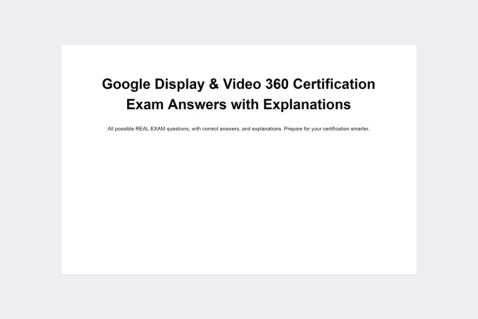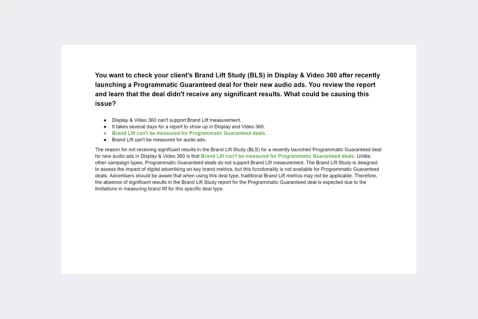You have the winning bid at a second-price auction for inventory in Display & Video 360, at $12. The second-highest bidder bids $8. How much will you pay for these impressions?
$12.00
$8.01
$8.00
$12.01
Certification program: 👉 Google Display and Video 360 certification exam
Explanation: In a second-price auction model within Display & Video 360, the winning bidder pays the price of the second-highest bid plus $0.01. Therefore, with the winning bid at $12 and the second-highest bid at $8, the winning bidder will pay $8.01 for these impressions. This pricing mechanism encourages advertisers to bid their true value for impressions, as the winning bidder pays a price that reflects the perceived value by the second-highest bidder, promoting a fair and competitive auction environment.
Passing exams is not a workout. Multiple attempts won’t make you stronger.



- All possible Google Display and Video 360 certification exam questions with answers, and explanations.
- Real certification exam questions
- Detailed answer explanations.
- Reflects exactly the latest real exam questions.
- Free Lifetime updates.
Understanding Second-Price Auctions in Display & Video 360
In the dynamic world of digital advertising, auction mechanisms play a crucial role in determining the price and allocation of ad inventory. One such mechanism widely used in platforms like Display & Video 360 is the second-price auction.
What is a Second-Price Auction?
In a second-price auction, the highest bidder wins the auction but pays the price of the second-highest bid. It might sound counterintuitive at first, but this pricing model has strategic implications for advertisers.
Example Scenario
Let’s illustrate this with an example. Suppose you participate in a second-price auction for ad inventory in Display & Video 360. You place a bid of $12, which turns out to be the highest bid. The second-highest bid in this auction is $8.
How Much Will You Pay?
Despite your bid being $12, you will only pay $8 for the impressions. This is because the auction follows the second-price rule, where the winning bidder pays the price of the second-highest bid.
Practical Insights
Understanding second-price auctions is crucial for advertisers to optimize their bidding strategies. Here are some practical insights:
-
Bid Strategically: Knowing that you’ll only pay the price of the second-highest bid, it’s essential to strategize your bidding to maximize ROI.
-
Avoid Overpaying: Bidding excessively high might lead to overpaying for impressions, as you’ll still pay the price of the second-highest bid.
-
Monitor Competitor Activity: Keeping an eye on competitors’ bidding patterns can help you gauge market demand and adjust your strategies accordingly.
Personal Experience
In my experience working with Display & Video 360 campaigns, understanding auction dynamics has been instrumental in achieving campaign goals. I’ve seen instances where careful bidding strategies have resulted in significant cost savings without compromising on performance.
Conclusion
Second-price auctions are a fundamental aspect of ad inventory trading in platforms like Display & Video 360. By grasping the mechanics of these auctions and implementing strategic bidding practices, advertisers can optimize their ad spend and drive better results for their campaigns.
For more insights on digital advertising and auction dynamics, stay tuned to our blog!
Discover our best-value guides
- Special Bundle Offer Google_Ads_Roll
- Special Bundle Offer HubSpot_Exams_Roll
- Special Offer Unchained_Guru_Roll
- Special Bundle Offer Amazon_Roll
- Special Bundle Offer Google_Analytics_Roll
- Special Bundle Offer Google_SkillShop_Roll
- Special Bundle Offer Marketing_Platforms_Roll
- Special Bundle Offer Microsoft_Advertising_Roll
- Special Bundle Offer YouTube_Roll
- Special Bundle Offer Google_Android_Roll
- Ultimate PMP certification preperation guide
- Google Cloud Professional Architect Certification Exam Answers - Ultimate Guide
- Special Bundle Offer SEMrush_Roll